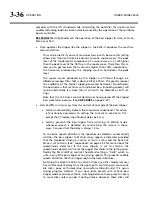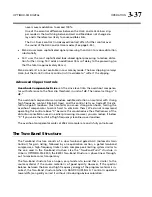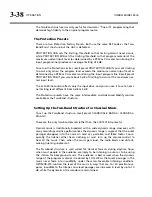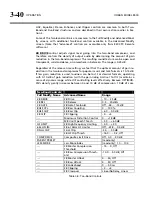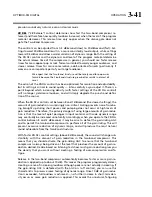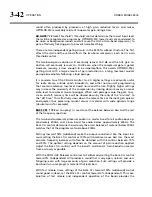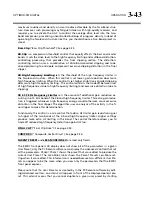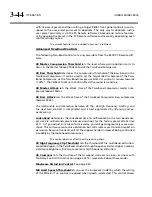
OPTIMOD-FM DIGITAL
OPERATION
3-29
noise or background sounds and cause the AGC or multiband compressor to gate,
effectively freezing gain to prevent noise breathing.
There are two independent gating circuits in the 8300. The first affects the
AGC
and
the second affects the
multiband compressor
. Each has its own threshold control.
The multiband compressor gate causes the gain reduction in bands 2 and 3 of the
multiband compressor to quickly move to the average gain reduction occurring in
those bands when the gate first turns on. This prevents obvious midrange coloration
under gated conditions, because bands 2 and 3 have the same gain.
The gate also independently freezes the gain of the two highest frequency bands
(forcing the gain of the highest frequency band to be identical to its lower
neighbor), and independently sets the gain of the lowest frequency band according
to the setting of the
DJ
B
ASS
boost control (in the Equalization screen). Thus, with-
out introducing obvious coloration, the gating smoothly preserves the average
overall frequency response “tilt” of the multiband compressor, broadly maintaining
the “automatic equalization” curve it generates for a given piece of program mate-
rial.
If the
MB
G
ATE
T
HR
(Gate Threshold) control is turned
O
FF
, the
DJ
B
ASS
control is disabled.
AGC B CPL
(“AGC Bass Coupling”) control clamps the amount of dynamic bass
boost (in units of dB) that the AGC can provide. (In V2.0, the unit of measure was
percent.)
The AGC processes audio in a master band for all audio above approximately 200 Hz
and a bass band for audio below approximately 200 Hz. Starting with V2.1 software,
the AGC Master and Bass compressor sidechains operate without internal coupling.
The gain reduction in the Bass audio path is either the output of the Bass compres-
sor sidechain or the output of the Master band sidechain. The
AGC
B
ASS
C
OUPLING
control sets the switching threshold. For example, if the
AGC
B
ASS
C
OUPLING
control
is set to 4 dB and the master gain reduction is 10 dB, the bass gain reduction cannot
decrease below 6 dB even if the gain reduction signal from the Bass compressor
sidechain is lower. However, the audio path bass gain reduction can be larger than
the master gain reduction without limit. In the previous example, the bass gain re-
duction could be 25 dB
The normal setting of the AGC
B
ASS
C
OUPLING
control is 0 dB, which allows the AGC
bass band to correct excessive bass as necessary but does not permit it to provide a
dynamic bass boost.
Note that the operation of this control was changed in 8300 V2.1 software to work
as explained above. You may have to tweak this control to achieve the same bass
balance that you had previously with V2.0 software.
AGC METR (“AGC Meter Display”)
determines what signal the front-panel AGC
meter displays.
M
ASTER
displays the gain reduction of the Master (above-200 Hz)
band.
D
ELTA
displays the difference between the gain reduction in the Master and
Bass bands. Full-scale is 25 dB gain reduction.
Summary of Contents for 8300J
Page 1: ...Operating Manual OPTIMOD FM 8300 Digital Audio Processor Version 2 1 Software...
Page 7: ...Operating Manual OPTIMOD FM 8300 Digital Audio Processor Version 2 1 Software...
Page 24: ......
Page 94: ...2 46 INSTALLATION ORBAN MODEL 8300 This page intentionally left blank...
Page 190: ......
Page 204: ......
Page 246: ......
Page 247: ...OPTIMOD FM DIGITAL TECHNICAL DATA 6 29...
Page 254: ...6 36 TECHNICAL DATA ORBAN MODEL 8300 CPU Module...
Page 260: ...6 42 TECHNICAL DATA ORBAN MODEL 8300 8300 RS232 BOARD PARTS LOCATOR...
Page 262: ...6 44 TECHNICAL DATA ORBAN MODEL 8300 8300 POWER SUPPLY PARTS LOCATOR...
Page 264: ...6 46 TECHNICAL DATA ORBAN MODEL 8300 8300 I O BOARD PARTS LOCATOR...
Page 270: ...6 52 TECHNICAL DATA ORBAN MODEL 8300 DSP BOARD PARTS LOCATOR DRAWING 32170 000 14...
Page 278: ...6 60 TECHNICAL DATA ORBAN MODEL 8300 8300 DISPLAY BOARD PARTS LOCATOR...
Page 279: ...OPTIMOD FM DIGITAL TECHNICAL DATA 6 61 DISPLAY BOARD...






















